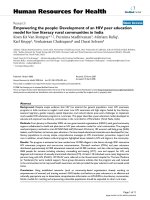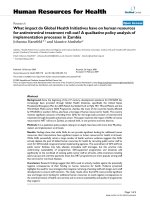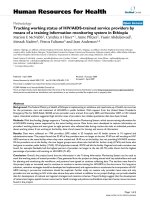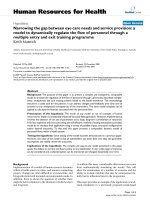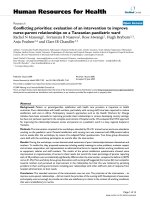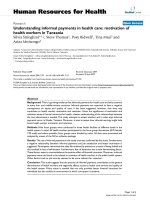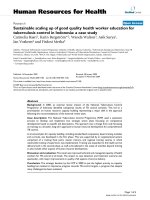báo cáo sinh học:" Towards the construction of health workforce metrics for Latin America and the Caribbean" pot
Bạn đang xem bản rút gọn của tài liệu. Xem và tải ngay bản đầy đủ của tài liệu tại đây (292.57 KB, 9 trang )
CASE STUD Y Open Access
Towards the construction of health workforce
metrics for Latin America and the Caribbean
Gustavo G Nigenda Jr
1*
, Maria H Machado
2
, Fernando F Ruiz
3
, Victor V Carrasco
4
, Patricia P Moliné
5
and
Sabado S Girardi
6
Abstract
Introduction: One of the components of the Health Observatory for Latin American and the Caribbean (HO-LAC)
is the design and implementation of metrics for human resources for health. Under the HO-LAC initiative,
researchers from nine countries in the region formed the Collaborative Community on Human Resources for
Health in Latin America and the Caribbean to identify comm on metrics applicable to the field of human resources
for health (HRH).
Case description: The case description comprises three stages: a) the origins of an initiative in which a non-
governmental organization brings together researchers involved in HRH policy in LAC, b) a literature search to
identify initiatives to develop methods and metrics to assess the HRH field in the region, and c) subsequent
discussions held by the group of researchers regarding the possibilities of identifying an appropriate set of metrics
and indicators to assess HRH throughout the region.
Discussion and evaluation: A total of 101 documents produced between 1985 and 2008 in the LAC region were
identified. Thirty-three of the papers included a variety of measurements comprising counts, percentages,
proportions, indicators, averages and metrics, but only 13 were able to fully describe the methods used to identify
these metrics and indicators. Of the 33 articles with measurements, 47% addressed labor market issues, 25% were
about working conditions, 23% were on HRH training and 5% addressed regulations. Based on these results,
through iterative discussions, metrics were defined into three broad categories (training, labor market and working
conditions) and available sources of information for their estimation were proposed. While only three of the
countries have data on working conditions, all countries have sufficient data to measure at least one aspect of HRH
training and the HRH labor market.
Conclusions: Information gleaned from HRH metrics makes it possible to carry out comparisons on a determined
experience in space and time, in a given country and/or region. The results should then constitute evidence for
policy formulation and HRH planning and programs, with improved health system performance ultimately
contributing to improved population health. The results of this study are expected to guide decision making by
incentivizing the construction of metrics that provide information about HRH problems in LAC countries.
Background
This paper describes the initial efforts of a regional non-
governmental initiative in laying the foundation of a fra-
mework to analyse the field of human resources for
health (HRH) in Latin America and the Caribbean. It
provides information about the origins of the initiative,
preliminary collection of information by means of a
literature search and the ensuing discussions leading to
a set of metrics and indicators to be used in monitoring
HRH policies in the region.
Historically, as in other developing region,s the process
of construction, dissemination, and utilization of infor-
mation on HRH in Latin America and the Caribbean
(LAC) has had its ups and downs. The past 10 years have
seen uneven progress in the implementation of HRH
information systems across countries in the region [1].
For many governments the issue of HRH is not a priority:
on one hand planning and regulation are considered too
* Correspondence:
1
Health Services and Systems Innovations, Health Systems Research Centre,
National Institute of Public Health, Cuernavaca, Mexico
Full list of author information is available at the end of the article
Nigenda et al. Human Resources for Health 2011, 9:24
/>© 2011 Nigenda et al; licensee BioMed C entral Ltd. This is an Open Access article distribu ted under the terms of the Creative
Commons Attribution Li cense ( icenses/by/2.0), which permits unrestricted use, distribution, and
reproduction in any medium, provided the original work is properly cited
complex due to the political nature underlying the issue;
and on the other, investing in the creation of information
sys tems is considered very ex pensive and offers no guar-
antee of providing expected benefits [2]. However, during
the past decade a number of regional initiatives have
emerged which encourage governments to consider the
relevance of HRH and to promote and support the devel-
opment of information systems.
In 1999 the Observatories of Human Resources in
Health [3], an initiative led by the Pan American Health
Organization (PAHO), were established with the participa-
tion of the International Labor Organization (ILO), the
Economic Commission for Latin America and the Carib-
bean (ECLAC) and nine signatory countries: Brazil, Chile,
Costa Rica, Ecuador, El Salvador, Jamaica, Mexico,
Panama and Peru. By 2004, 21 countries in the Americas
had joined the network of observatories [4]. Since then,
more than a dozen international meetings have triggered
numerous domestic and multinational activities, strategies,
studies and collaborative projects capable of generating
scientific information on the training, labor market and
regulatory processes affecting technicians and profes-
sionals involved in health promotion and the provision of
preventive and curative services for populations.
A 2005 meeting in Toronto was key, as representatives
from governments, professional organizations and aca-
demic institutions from the Americas gathered together to
identify strategic challenges. These included long-term
policies to adjust HRH to health system changes and epi-
demiological profile dynamics, equitable geographical dis-
trib ution of health workers, effective regul ation of health
workers, promotion of quality work environments for
health workers and interaction mechanisms between train-
ing and employment institutions; all with the aim of
improving the capacity of health care systems to achieve
their goals. The meeting was convened by PAHO, the
Canadian Ministry of Health and World Health Organiza-
tion (WHO). Thirteen agreements were reached to achieve
the aforementioned objectives, the most important being
to consolidate the governance capacity of health and edu-
cational authorities and to increase investment in HRH
development [5].
Despite these important developments, however, policies
are still lacking key data that can define t argets to be met
by programmes and policies, monitor their development
and allow evaluations to assess c apacity to achie ve these
targets and goals. The availability of information is hetero-
geneous across the region, thus a comparative approach
across countries has not been possible. Non-governmental
initiatives geared toward the capacities and resources of
health sector institutions have expanded in order to
strengthen public policies. The case des cribed in the follow-
ing sections illustrates the relevance of non-governmental
organizations in bringing together researchers and HRH
specialists to discuss potential metrics and indicators to
monitor country-based and regional policies. This effort, in
turn, implies the possibility of harmonizing and am algamat-
ing databases in order t o be able to produce comparable
metrics.
Case description
Initiative origins
The field of HRH in Latin Am erica and the Caribbean
reveals a broad and complex picture framed by the
advancement of broad health systems reforms and the het-
erogeneous application of public policies to regulate and
plan supply and demand of health personnel over time.
Using various methodological approaches, the study of
HRH in LAC in recent years is predominantly descriptive
and mainly focused on aspects of t raining and the defini-
tion of educational content for different health disciplines.
Within this context, the Carso Health Institute, in colla-
boration with the Mexican Health Foundation, fostered
the creation of a Mexico-based Health Observatory for
Latin America and the Caribbean (HO-LAC), with one
main component dedicated to the construction of metrics
in human resources for health. Under this initiative the
Collaborative Community on Human Resources for
Health in Latin America and the Caribbean (COCORHS
in Spanish) was established in 2008 in Mexico City. The
network includes researchers from Argentina, Bolivia, Bra-
zil, Chile, Colombia, Costa Rica, the Dominican Republic,
Mexico, and Peru. Its main objectives are:
• To create a space for developing and promoting
health metrics that generate useful information and
evidence for decision making.
• To identify common metrics applicable to different
areas of HRH in LAC, including the priority areas of
training, labor market and working conditions, as
well as regulatory issues.
To advance toward the achievement of these objectives,
the COCORHS carried out, in the first trimester of 2009,
initial searches and analyses of bibliographic material that
included measures developed in the previously-mentioned
topic areas and that had utilized some sort of metric. The
following sub-section describes the methodology and
results of this literature review.
Clearly, there have been various attempts to generate
data, indicators and measures to monitor HRH perfor-
mance not only for training processes but also to inform
the labor market and other sectors, with varying degrees
of success [6]. It is also clear, according to WHO reports,
that country databases are frequently structured under dif-
ferent arrangements, which makes it difficult to design
indicat ors according to pre-defined parameters and, con-
sequently, to ensure their comparability.
Nigenda et al. Human Resources for Health 2011, 9:24
/>Page 2 of 9
Compiling comparable HRH metrics for the region pre-
sents a great challenge given the total or partial lack of -
and dispersion of - data on HRH in LAC countries.
Acknowledging the main cons traints to accessing an d
using detailed, classified and disaggregated quantitative
information on various HRH aspects, researchers from dif-
ferent LAC countries have launched a joint effort to con-
struct standardized metrics permitting the systematization,
comparison and analysis of data to support national and
regional policy proposals on specific HRH topics.
Literature review
The literature review was carried out in several stages,
with the first stage consisting of bibliographic searches for
publications about HRH in Latin America and the Carib-
bean containing quantitative data and measures. A search
of grey literature and policy documents not included in
public databas es constituted another stage, the objective
or which was to thoroughly review and identify studies
originating in LAC countries containing HRH data, meth-
ods and metrics.
For the COCORHS, metrics are conceived of as a set of
calculations that allow the measurement of individual and
population aspects of health [7]. To provide an interpreta-
tive framework for this search, metrics were defined as
‘the measurement(s) used to determine the quantitative
dimension of the occurrence of a phenomenon in the field
of HRH’. A metric should preferably correspond with
some, if not all, of the following characteristics: a) b e
based on a theoretical construct, b) use standardized para-
meters for measurement and comparability, c) link two or
more variables, and d) aim to guide decision making.
Data collection and analysis
Publications were chosen for exhaustive review if they
met the following criteria:
• Available in English, Spanish and Portuguese; pub-
lished between 1980 and 2008. Since the majority of
documents came from 1985 and later, this year was
defined as the beginning of the period.
• Containing quantitative measurement indicators on
HRH training, labor market or working conditions.
Publications containing only qualitative information or
that were exclusively theoretical approaches to the field
of HRH were excluded.
Health and social sciences databases s uch as LILACS,
SciELO, EBSCO, the WHO search engine, and the Vir-
tual Health Library were searched. In order to narrow the
information we used the following keywords in Spanish
(and the corresponding words in Portuguese): personal
de salud, recursos humanos para la salud, disponibilidad
de recursos humanos para la salud, métricas de recursos
humanos para la salud, análisis situacional de recursos
humanos para la salud, perfil de los recursos humanos
para la salud, indicadores de recursos humanos para la
salud, salarios de los trabajadores de la salud, tendencias
de la fuerza laboral en salud, entrena miento del personal
de salud; and in English: health workforce, human
resources for health, availability of human resources for
health, metrics for human resources for health, situa-
tional analysis of human resources for health, profile of
human resources for health, human resources for health
indicators, health worker salaries, health labor force
trends, health personnel training.
Also, COCORHS members were asked to submit the
most up-to-date quantitative data and information on
HRH, particularly grey literature and official reports from
their respective countries considering the study’sthree
broad fields, to help ensure that the most relevant publi-
cations and information in the field of HRH metrics were
included.
Systematization of the collected documents was divided
into two phases. The objective of the first phase was to
have an initial situational analysis of HRH metrics in the
region, thus all available documents from LAC were
included. The second phase sought to identify HRH
metrics developed in other regions to be used as a refer-
ence when constructing common metrics for the LAC
region (this phase is yet to be completed).
The preliminary findings of the literature search were
collectively discussed during two in-person meetings by
the members of the network, this activity being described
further in the third sub-section. The initial discussion
sought to identify whether the broad areas defined in the
theoretical framework matched with those identified in
the literature and to consider the need to include other
areas. After the discussion of each broad area, specific
metrics were identified. The initial number of identified
metrics was larger than the final number included. The
final set of metrics was obtained by considering the rele-
vance of the metric and the data available to estimate it.
Fromtheliteraturesearch,atotalof101documents
with information on human resources for health originat-
ing in the LAC region were compiled; 33 of these included
some type of measurement in the human resource s field.
The publications came from the following countries:
Argentina (1), Brazil (7), Colombia (2), Costa Rica (1),
Cuba (1), Dominican Republic (1), Ecuador (1), Mexico
(7), Nicaragua (2), Paraguay (1), Peru (3), Uruguay (1) as
well as several international collaborations (5) involving
Bolivia, Colombia, Ecuador, El Salvador, Mexico, Peru and
Venezuela.
From the 33 included publications a variety of mea-
surements were identified, including counts (number of
doctors); percentages (distribut ion by sex, employment
sector); proportions ( number of nurses per doctor);
Nigenda et al. Human Resources for Health 2011, 9:24
/>Page 3 of 9
indicators (percentage of increase of HRH between time
periods); and averages (annual number of consultations
givenbydoctor).Onlysomeofthesemeasurementsfit
the metrics definition.
To inform the systematization of HRH metrics, the
included papers were also classified according to type of
publication, with the largest proportions corresponding
to indexed articles (27.3%) and official government
documents (including HRH plans and reports) (21.2%)
(see Table 1).
Measurements included in the 33 publications
addressed labor market issues (47%), working conditions
(25%), HRH training (23%) and regulatory aspects (5%)
(see Figure 1).
Based on the number of publications produced, promi-
nent LAC countries include Mexico with 9 documents
(27.2%), Brazil with 7 (21.2%), Peru with 3 (9.1%), and
Bolivia and Colombia each with 2 (6.1% each). Of the total
publications identified, 22% were the result of multi-coun-
try collaborations and/or working groups that develop
international initiatives in the HRH field, as in the case of
the OECD group.
More than three-quarters (24) of the publications
included in the study used measurements such as ratios,
proportions and percentages, while 21% (7 publications)
contained more elaborately developed metrics that fit
the previously outlined definition (Table 2).
Discussion and evaluation
COCORHS discussions to identify key metrics and
indicators
This initial review of the literature yields results useful for
building state of the art HRH metrics in Latin America
and the Caribbean, identifying metrics on specific HRH
issues, promoting comparative studies and formulating
new goals in the creation of feasible and concrete metrics
applicable to a large number of countries in the region.
All identified metrics have been selected with the aim
that they reflect a specific dimension of human resources
for health in the fields of training, employment, working
conditions and regulatory aspects. As such, all metrics
can be included in the conceptual framework which
emphasizes the understanding of the HRH field as a
market with specific types of regulations. It is possible to
identify a larger number of m etrics across these four
fields. However, for the application of metrics to the
design and monitoring of policies in developing coun-
tries, a certain level of pragmatism is important regarding
the availability of data to be able to estimate them.
Moreover, as a central element in the discussion of
metrics, HRH metrics should be capable of informing
comparisons over time and spac e, in countries and/or
regions, concerning a particular experience in the field of
HRH [8]. In other words, metrics should permit compari-
sons that aim to identify the position of every country
regarding a given issue. Some of the metrics identified
have provided evidence for policy and program formula-
tion and planning for human resources, particularly those
related to training and geographical distribution. Develop-
ing short and medium term scenarios can be one of the
most valuable applications of metrics for decision making
in human resource planning [9].
Not only is current conceptual development in HRH
metrics limited, but so too is the development of methods
and formulae allowing the measurement of situations such
as the relationships among health personnel, their working
conditions and population health [10]. Developing HRH
metrics related to the health status of the population
requires deeper conceptual analysis and reflection, further
complicating its applicability to different contexts.
Regarding the measurements in use in individual coun-
tries, one important advancement is that practically all of
the countries have implemented systems to track the
numbers of health workers and have estimated propor-
tions of health personnel by such measures as population
size, number of hospital beds, existence of formal employ-
ment ties, state or municipality, health worker level and/or
are a of training and w hether a heal th worker has patient
contact. It is now common to estimate the number and
Table 1 Number, percentage and type of publications
presenting some type of measurement
Type of publication Number Percentage
Indexed articles 9 27
Articles published in non-indexed journals 6 18
Book chapters 3 9
Published books 4 12
Official documents 7 22
Others 4 12
Total 33 100
Figure 1 Distribution of topics identified in the sel ected
publications.
Nigenda et al. Human Resources for Health 2011, 9:24
/>Page 4 of 9
geographical distribution of HRH by area and/or type of
health personnel, as well as existing institutional capacity
to meet population health care needs and achieve national
health goals. However, in health systems the development
of human resources has been especially complicated by
aspects such as increased demand, the ability or inability
to respond to marked changes in a country’s epidemiologi-
cal profile, migratory trends and labor market dynamics
[11].
The results of the literature review were discussed at
two meetings held in San Jose, Costa Rica, in November
of 2009 and in Rio de Janeiro in November 2010,
attended by fifteen members of the COCORHS, repre-
senti ng eight countries in the network (Argentina, Brazil,
Colombia, Costa Rica, Chile, the Dominican Republic,
Mexico, and Peru) in addition to three international
HRH experts.
Discussions held by the group in the Costa Rica meet-
ing led to the following conclusions:
1. Three areas or categories were defined for devel-
oping and estimating HRH metrics: a) training, b)
labor market, and c) working condit ions. These
areas match those previously defined by the theoreti-
cal framework. Regulatory issues were dropped due
to a t otal lack of quantitative data available in the
region to estimate them.
2. A total of seven topics within the three main areas
were defined, two under in-training, three related to
labor market and two under working conditions
(Table 3). The second topic initially included in the
labor conditions category was ‘formal negotiation of
employer-employee a greements’, but was later changed
to ‘stable job’.
The area with the fewest identified options for obtain-
ing information was labor conditions, for which only
Argentina, Brazil, Chile and Mexico have available data
(Table 3). On the other hand, every country has the
training and labor market categories covered by at least
one of their defined metrics (Table 3). Additionally, all
countries report having information on the volume of
personnel trained and the distribution of HRH in the
labor market. Regulatory mechanisms were n ot consid-
ered to be a field for metrics definition, as the vast
majority of information in this area is not quantitative.
In Rio de Janeiro, follow-up discussions led to a still
more simplified set of metrics due to data restrictions. For
example, the original indicator ‘labor wastage’ summariz-
ing unemployment and underemployment rates, has been
estimated in Mexico for doctors [12] and nurses [13] but
was dropped because there i s no available data in other
countries. A further agreement was also to estimate agreed
metrics and indicators in each member country, an activity
that is currently taking place. The group will eventually
meet by the end of 2011 to discuss the findings of country
cases.
Discussion and evaluation of case study findings
The present document describes a strategy followed by a
group of public health researchers in Latin America and
the Caribbean to identify metrics in the field of human
resources for health that could be used to monitor policies
and inform decision makers on both country-specific and
regional HRH issues.
The first step was to carry out a literature search to
identify HRH metrics in line with a conceptual frame-
work that included four broad topics and a specific defi-
nition of the metrics concept that led us to work with
theoretically grounded measurements that could be com-
parable across c ountries and meaningful to the decision
making process [14].
Representing only 7% of all the publications, those
with specific metrics on the health workforce are quite
scarce in the LAC region overall, with the exception of
Brazil, Colombia, Mexico, Nicaragua and Peru, and the
initiatives of international collaborations.
Of the metrics in HRH, 70% are concentrated in the
fields of labor market and health personnel working con-
ditions. In these areas, metrics typically are related to the
Table 2 Publications with metrics descriptions.
Country Metric
1. Brazil [18] Develops an index to measure job instability among nursing personnel.
2. Colombia
[19]
Proposes a formula for calculating HRH supply and demand. Quantifies tasks assigned to nurses and uses formulae to substitute
occupational profiles.
3. Mexico [20] Generates formulae to calculate labor wastage in five occupational categories.
4. Peru [21] Presents information regarding the four areas of HRH and develops an analysis of in-country HRH distribution.
5. Peru [22] Uses formulae for projecting physician demand and needs between 2006 and 2011. Makes projections of physician supply and
needs in Peru.
6. Nicaragua
[23]
Proposes formulae for calculating the number of physicians required according to hospital profile; and calculations to determine
nursing personnel, general practitioners required to meet hospital admission demands, and nursing staff needs.
7. Mexico [24] Uses formulae to measure occupational status, rates of unemployment, and underemployment.
Nigenda et al. Human Resources for Health 2011, 9:24
/>Page 5 of 9
Table 3 Availability of information on specific topics as defined by COCORHS members, by category and country
Categories and topics Argentina Brazil Chile Colombia Mexico Peru Dom. Rep.
TRAINING
Professional profile according to health delivery model X X X X
Volume of professionals trained X X X X X X X
LABOR MARKET
Occupational status: employment, unemployment, under-employment, multi-employment X X X
Salary XXX X
Distribution: geographical, level of care, sex, sector (public-private) X X X X X X X
WORKING CONDITIONS
Workplace conditions X X X
Stable job XX X
Nigenda et al. Human Resources for Health 2011, 9:24
/>Page 6 of 9
estimation of employment, unemployment, unstable
employment, und eremployment, allocation of personnel,
the potential demand for HRH and labor wastage. Sur-
prisingly, scarce literature was identified in the area of
training. Most publications addressing the topics of inter-
est focus exclusively on doctors, nurses and dentists;
rarely are other health sector professions included.
To arrive at a comprehensive situational analysis of the
status of HRH training and the labor market, and the need
to expand and/or reconsider regulations in either area, pro-
gress must be made in constructing systematic measure-
ments with common methodologies at the local, national
and international level. A comprehensive and detailed
situational analysis on HRH is possible throu gh creating
and developing metrics. Efforts made during the past two
decades in LAC have been important, but insufficient to
generate macro and micro situational analyses by country
or region. New indicators and metrics are needed to define
and guide policy formulation and decision making.
The next step in the field of HRH is to promote similar
research that includes a more extensive bibliographic
review from various sources in different LAC countries,
permitting a more intensive search for available metrics in
additional areas in the HRH field, such a s regulation,
working conditions and workers’ health. To enrich pri-
mary sources and expand the references in this field, it i s
of great importance to identify available databases within
each country, specifying available quantitative HRH infor-
mation with which metrics can be constructed.
Promoting metrics innovation and development is a
rarely addressed area of HRH. Metrics can promote a dee-
per unde rstanding of each of the topic areas and provide
key information allowing policy tracking and monitoring.
This will help to position HRH metrics as a fundamental
tool for concrete aspects of planning, policy definition and
decision making at the institutional and sector-specific
level.
The results from this study can serve as a foundation
from which to follow up, analyze and discuss the HRH
metrics identified, with the goal of selecting some of the
metrics for application in countries with a COCORHS
representative.
This study’s results will surely serve as an incentive for
participating COCORHS countries to construct key
metrics in each of the main HRH areas, in response to
each country’s priority problems, such that information
can be generated and made available to decision makers.
In fact, this will be the substantive contribution of the
Collaborative Community’s second phase of work. It is
clear that the development of metrics has to consider
cross-country comparison despite the existing differences
in data production in each country. A first effort has to
focus on standardizing the production of every metric,
guaranteeing that available sources (particularly
secondary ones) present data in a way that allows for the
production of every selected metric, particularly as relates
to coding and data aggregation.
Selection of metrics by COCORHS is based on the
assumption that HRH participation is inter-linked across
four broad fields. The first of them is the training pro-
vided by schools, through which the supply of indivi-
duals with specific capacities and skills is generated.
These individuals eventually perform different activities
related to the production of health services. These activ-
ities could be related directly to production by participa-
tion in clinical activities, or indirectly related through
teaching, planning or evaluation of health provision.
The second field, labor market, generates the demand
for those individuals trained at schools to be incorpo-
rated into the production process. However, generally
speaking not all graduates can be incorporated into the
health labor market, producing negative effects such as
unemployment and underemployment.
The third field consists of the employment conditions
of health personnel, which are mainly characterized by
the t ype of link the personnel have with the labor mar-
ket. The link can be salaried in cases when workers
obtain a position within public and/or private institu-
tions through a contract or v erbal agreem ent. A second
type of link is independent practice where a worker
(mainly doctors and dentists) can set up their own prac-
tice and charge fees for services to their clients, or be
paid by third party payers.
These three fields, in turn, are subjected to regulatory
processes (the fourth field) which define, on the training
side: the contents of training, duration, requisites for
obtaining a degree, training at specialty levels, etc. On
the labor market side regulations define: aspects of plan-
ning and geograp hical and institutional distribution. For
working conditions, issues such as type of contract,
work schedule, income and benefits are considered. It is
also important to poi nt out that regulatory agencies are
normally different from those which train and contract
personnel. Metrics and indicators selected by
COCORHS can be located in these four fields [15,16].
Conclusions
An HRH metric should provide information permitting
assessments over time, and in a specific country or
region, with regard to a given phenomenon in the HRH
field. Furthe rmore, the metric should guarantee compar-
ability, with the goal of identifying phenomena that can
be expressed numerically. Information provided by
metrics should constitute solid evidence within the tasks
of formulating policies, plans and programmes for HRH
and with the ultimate goal of improving the performance
of health systems as a means to improve population
health conditions.
Nigenda et al. Human Resources for Health 2011, 9:24
/>Page 7 of 9
One of the most valuable areas for metrics application
is the HRH field, as it could be useful in carrying out
planning of HRH within the health care system, framed
in a manner that allows policy makers to make adequate
decisions for short and long term adjustments.
Laying a foundation for the selecti on and estimation of
metrics is difficult due to the lack of a conceptual frame-
work. So, too, is the development of methods and metrics
that could allow the measurement of phenomena concern-
ing the link between health personnel, their participation
in health activities, and population health indicators. The
development of metrics linking HRH with health condi-
tions requires deeper analytical and conceptual develop-
ments, making this a later analytical stage [17].
Regarding measurements developed across countries, an
important advancement is the fact that most countries
(including developing ones) have put in place systems to
count health personnel and identify indicators related to
population size, contact with patients, number of beds and
health care units. It may be a common denominator today
to be able to estimate the presence of health personnel by
region and the institutional capacity to provide health ser-
vices to populations and reach health goals. However, the
participation of HRH within health systems has become
more complex due to elements related to organizational
complexities, the capacity to respond to an evident change
in the population’s epidemiological profile and labor mar-
ket dynamics. Innovations are needed to respond to most
of these challenges, including adequate performance of
HRH within institutions.
The lack of academic and policy documents that pro-
pose specific HRH participation metrics for HRH is
evident, with exceptions identified in Bolivia, Brazil,
Colombia, Mexico, Nicaragua and Peru, as well as the
initiatives developed by international agencies. Metrics are
concentrat ed in educati onal and labor market issues, but
scarce in working condition-related and regulatory issues.
It is of critical importance to discuss theoretical frame-
works that could provide the foundation for relevant
metrics in the HRH field. Although metrics have been
described for specific LAC countries it is important to
homogenize these estimations throughout the region and
make them comparable. In some countries, data sources
are available but not used for these purposes, therefor e it
is of the essence for researchers to identify and use them.
Further effort s are needed to develop and apply relevant
metrics with the participation of all interested actors, gov-
ernments, researchers, NGOs and international agencies.
Acknowledgements
COCORHS members Leobardo Cuevas, Jacqueline Alcalde, José Arturo Ruiz,
Celia Pierantoni, Eliane Dos Santos, Carmen Vázquez, Werner Valdés, Alicia
Reyes, Mónica Abramzón, Elizabeth Aguilar, Rosa Bejarano and Sarah Lewis
are gratefully acknowledged for participa ting in the preparation of and
discussion about this document. COCORHS is a member network of the
Latin American and the Caribbean Health Observatory, an initiative
coordinated by the Mexican Health Foundation and financially supported by
the Carlos Slim Health Institute. Authors are grateful for the support received
from these institutions.
Author details
1
Health Services and Systems Innovations, Health Systems Research Centre,
National Institute of Public Health, Cuernavaca, Mexico.
2
Senior Researcher.
National School of Public Health. Osvaldo Cruz Foundation. Rio de Janeiro,
Brazil.
3
Center for Project Development. Pontificia Universidad Javeriana,
Bogota, Colombia.
4
Professor. Carlos Vidal Layseca School of Public Health
and Administration. Cayetano Heredia Peruvian University. Lima, Peru.
5
Advisor. Plenitud Foundation, Santo Domingo, Dominican Republic.
6
Researcher. Center for Public Health Studies. Federal University of Minas
Gerais. Belo Horizonte, Brazil.
Authors’ contributions
GN coordinated the bibliographic review and the systematization of the
information collected and was responsible for the study design and analysis.
MM participated in the development of the theoretical framework and the
final analysis. FR participated in the design of the analytical strategy. VC
participated in the literature review, and PM and SG participated in the
analysis of final information. All authors have read and approved the final
manuscript.
Authors’ information
GN, MM, and SG, have carried out research in the HRH field for the past 20
years as well as in the health policy field. VC and FR teach health topics in
prestigious private universities in Peru and Colombia respectively, including
issues in HRH. PM participates in civil society organizations in the Dominican
Republic and other countries, carrying out evaluations of social programs.
Competing interests
The authors declare that they have no competing interests.
Received: 17 January 2011 Accepted: 14 October 2011
Published: 14 October 2011
References
1. PAHO: Health human resources trends in the Americas: evidence for
action. Washington, D.C: PAHO; 2006.
2. Novick M: Desafíos de la Gestión de los Recursos Humanos en Salud:
2005-2015. Washington, D.C: OPS; 2006.
3. Organización Panamericana de la Salud: Observatorio de los Recursos
Humanos en Salud Quito; 2000.
4. Observatorio de Recursos Humanos en salud en Brasil. [s.
org.br/rh/publicacoes/textos/ACF398.pdf].
5. OPS/OMS: Llamado a la Acción de Toronto 2006-2015: Hacia una Década
de Recursos Humanos para la Salud en las Américas. Reunión Regional
de los Observatorios de Recursos Humanos en Salud: 4 al 7 Octubre
2005. Ontario, Canadá. Editado por OPS/OMS; 2006, 1-9.
6. Bloor K, Maynard A: Planning Human resources in health care: Towards
an economic approach. An International comparative review. Ottawa
Canadá 2003.
7. Metricas de la Salud. [ />8. Anand S, Bärnighausen T: Health workers and vaccination coverage in
developing countries: an econometric analysis. Lancet 2007, 369:1277-85.
9. Dussault G, Dubois CA: Human resources for health policies: a critical
component in health policies. Human Resources for Health 2003, 1:1.
10. Anand S, Bärnighausen T: Human resources and health outcomes: cross-
country econometric study. Lancet 2007, 369:1277-1285.
11. Simoens S, Villeneuve M, Hurst J: The Supply of Physician Services in
OECD Countries. OECD Health Working papers NO. 21. Paris; 2003.
12. Nigenda G, Ruiz JA, Bejarano R: Educational and labor wastage of doctors
in Mexico: towards the construction of a common methodology. Human
Resources for Health 2005, 3:3.
13. Nigenda G, Ruiz JA, Rosales Y, Bejarano R: Enfermeras con licenciatura en
México: estimación de los niveles de deserción escolar y desperdicio
laboral. Salud Pública Méx 2006, 48:22-29.
Nigenda et al. Human Resources for Health 2011, 9:24
/>Page 8 of 9
14. Diallo K, Zurn P, Gupta N, Dal Poz MR: Monitoring and evaluation of
human resources for health: an international perspective. Human
Resources for Health 2003, 1:3.
15. WHO: Colaboremos por la salud. Informe sobre la salud en el mundo.
WHO. Ginebra; 2006, 135-152.
16. Nigenda G, Ruiz JA, González LM, Wirtz V, González MC, Aguilar E,
Bejarano R: Formación, empleo y regulación de los recursos humanos
para la salud: Bases para su planeación estratégica. Instituto Nacional de
Salud Pública/Centro de proyectos para el desarrollo Universidad Pontificia
Javeriana. Colombia; 2010, ISBN: 978-958-716-397-1.
17. Development of Regional HRH Indicators and Monitoring Template.
[ />18. Feitosa J, De Freitas J, Meneleu J: Precarización del trabajo de nivel
técnico en salud en el nordeste: un enfoque en las categorías de
auxiliar y técnico de enfermería. OPS/OMS; 2004.
19. Ruiz F, Camacho S, Eslava J: Recursos Humanos de Salud de Colombia.
Balance, competencias y prospectiva. Ministerio de la Protección Social/
Pontificia Universidad Javeriana; 2007.
20. Nigenda G, Ruiz JA, González LM, Wirtz V, González MC, Aguilar E,
Bejarano R: Formación, empleo y regulación de los recursos humanos
para la salud: Bases para su planeación estratégica. Instituto Nacional de
Salud Pública/Centro de proyectos para el desarrollo Universidad Pontificia
Javeriana. Colombia; 2010, ISBN: 978-958-716-397-1.
21. Arroyo J: Los sistemas descentrados de recursos humanos en salud: el
caso del Perú, 1990-2005. Universidad Peruana Cayetano Heredia; 2005.
22. Carrasco V, Lozano E y Velásquez E: Análisis actual y prospectivo de la
oferta, demanda y necesidad de médicos en el Perú 2005. Consejo
Nacional del Colegio Médico del Perú; 2007.
23. Ministerio de Salud de Nicaragua: Manual de procedimientos de planificación
y programación de recursos Managua; 2007.
24. Frenk J, Robledo C, Nigenda G: Patrones de empleo médico en las áreas
urbanas de México. Psicología y Salud 1988, 1:31-35.
doi:10.1186/1478-4491-9-24
Cite this article as: Nigenda et al.: Towards the construction of health
workforce metrics for Latin America and the Caribbean. Human
Resources for Health 2011 9:24.
Submit your next manuscript to BioMed Central
and take full advantage of:
• Convenient online submission
• Thorough peer review
• No space constraints or color figure charges
• Immediate publication on acceptance
• Inclusion in PubMed, CAS, Scopus and Google Scholar
• Research which is freely available for redistribution
Submit your manuscript at
www.biomedcentral.com/submit
Nigenda et al. Human Resources for Health 2011, 9:24
/>Page 9 of 9
